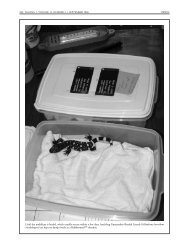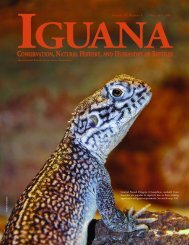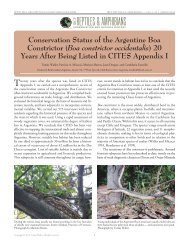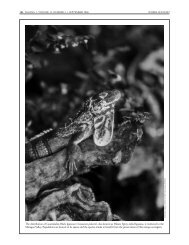Spiny-tailed Iguanas (Ctenosaura similis) in Venezuela
Spiny-tailed Iguanas (Ctenosaura similis) in Venezuela
Spiny-tailed Iguanas (Ctenosaura similis) in Venezuela
Create successful ePaper yourself
Turn your PDF publications into a flip-book with our unique Google optimized e-Paper software.
EDUARD ASENS PAGÉS<br />
SPINY-TAILED IGUANAS<br />
<strong>Sp<strong>in</strong>y</strong>-<strong>tailed</strong> <strong>Iguanas</strong> (<strong>Ctenosaura</strong> <strong>similis</strong>)<br />
<strong>in</strong> <strong>Venezuela</strong>: A Prelim<strong>in</strong>ary Report<br />
<strong>Ctenosaura</strong> <strong>similis</strong> is a large iguanid (see the excellent description<br />
<strong>in</strong> Savage 2002) that ranges from southern Mexico<br />
through Central America to Panama. The species is unknown<br />
<strong>in</strong> South America, but has been <strong>in</strong>troduced <strong>in</strong> Florida (Krysko<br />
et al. 2003) and the Colombian islands of Malpelo and San<br />
Andres (Forero-Med<strong>in</strong>a et al. 2006).<br />
Around 1998, Eduard Asens (pers. comm.) noticed large<br />
iguanids <strong>in</strong> the Barcelona area. Only two large lizards with dist<strong>in</strong>ctly<br />
different shapes, Tup<strong>in</strong>ambis teguix<strong>in</strong> and Iguana iguana,<br />
are known from coastal <strong>Venezuela</strong>. These lizards were identified<br />
from photographs as <strong>Ctenosaura</strong> <strong>similis</strong>. Because the area is a<br />
port, the assumption is that the species arrived with cargo<br />
shipped from Central America.<br />
The area where the iguanas occur is heavily developed, and<br />
is centered around a storage and market center named Lecherías<br />
along the road from Barcelona to Puerto La Cruz <strong>in</strong> the state of<br />
Anzoátegui, where they occur <strong>in</strong> gardens, park<strong>in</strong>g lots, and<br />
parks, but the population has expanded <strong>in</strong>to adjacent natural<br />
dry habitats. Because only a few adult males have been seen, the<br />
sex ratio of this population appears to be female-biased, or perhaps<br />
composed largely of subadults. In the developed areas, they<br />
are quite tolerant of people. No specimens have been collected;<br />
consequently, the photographs presented here<strong>in</strong> are the only<br />
vouchers for the presence of C. <strong>similis</strong> <strong>in</strong> <strong>Venezuela</strong>.<br />
<strong>Ctenosaura</strong> <strong>similis</strong> is known to produce clutches of 12–88<br />
(mean 43) eggs (Fitch and Henderson 1978). This species is<br />
ma<strong>in</strong>ly herbivorous but may feed opportunistically on <strong>in</strong>vertebrates<br />
and small vertebrates such as lizards, birds, eggs, and<br />
mammals. On Central American Caribbean islands, C. <strong>similis</strong> is<br />
known to prey on beach-nest<strong>in</strong>g birds and mar<strong>in</strong>e turtle hatch-<br />
César Luis Barrio-Amorós and Gilson Rivas-Fuenmayor<br />
IGUANA • VOLUME 15, NUMBER 3 • SEPTEMBER 2008 161<br />
Fundación AndígenA, Apartado Postal 210, 5101-A Mérida, <strong>Venezuela</strong> (cesarlba@yahoo.com)<br />
<br />
Ctenosaurs <strong>in</strong> the Barcelona area occur <strong>in</strong> heavily modified habitats<br />
such as gardens, park<strong>in</strong>g lots, and parks, but the population has<br />
expanded <strong>in</strong>to adjacent natural dry habitats. This is one of the few<br />
adult males observed.<br />
l<strong>in</strong>gs (Krysko et al. 2003). If the <strong>Venezuela</strong>n population expands<br />
to the east toward Mochima National Park or reaches the Paria<br />
Pen<strong>in</strong>sula, it might pose a threat to nest<strong>in</strong>g sea turtles (Chelonia<br />
mydas and Dermochelys coriacea). Although presumably subject<br />
to the same predators as Green <strong>Iguanas</strong> <strong>in</strong> the region, the population<br />
appears to be reproduc<strong>in</strong>g effectively.<br />
A study <strong>in</strong>vestigat<strong>in</strong>g the extent and impact of C. <strong>similis</strong> <strong>in</strong><br />
<strong>Venezuela</strong> is necessary to identify the possible threat this species<br />
poses to native plants and animals. The <strong>Venezuela</strong>n M<strong>in</strong>isterio<br />
del Ambiente, with the assistance of <strong>Venezuela</strong>n and <strong>in</strong>ternational<br />
herpetologists with expertise <strong>in</strong> <strong>in</strong>vasive populations of<br />
iguanas, should address the situation before control measures are<br />
no longer possible.<br />
Acknowledgments<br />
We thank Eduard Asens Pagés, Diego Flores Padrón, Piero<br />
Abbondanza, and Jose Alfredo Iglesias for shar<strong>in</strong>g data. Gunther<br />
Köhler identified the species based on photographs.<br />
References<br />
Forero-Med<strong>in</strong>a, G., O.V. Castaño-Mora, and M. Rodríguez-Melo. 2006.<br />
Ecología de Caiman crocodylus fuscus en San Andrés Isla, Colombia: Un<br />
studio prelim<strong>in</strong>ar. Caldasia 28:115–124.<br />
Savage, J.M. 2002. The Amphibians and Reptiles of Costa Rica. A Herpetofauna<br />
Between Two Cont<strong>in</strong>ents, Between Two Seas. University of Chicago Press,<br />
Chicago, Ill<strong>in</strong>ois, USA.<br />
Fitch, H.S. and R.W. Henderson. 1978. Ecology and exploitation of <strong>Ctenosaura</strong><br />
<strong>similis</strong>. University of Kansas Science Bullet<strong>in</strong> 51: 483–500.<br />
Krysko, K., F.W. K<strong>in</strong>g, K.M. Enge, and A.T. Reppas. 2003. Distribution of the<br />
<strong>in</strong>troduced Black <strong>Sp<strong>in</strong>y</strong>-<strong>tailed</strong> Iguana (<strong>Ctenosaura</strong> <strong>similis</strong>) on the southwestern<br />
coast of Florida. Biological Sciences 66:74–79.<br />
Females are difficult to dist<strong>in</strong>guish from subadult males. Most <strong>in</strong>dividuals<br />
fall <strong>in</strong>to one of these classes, suggest<strong>in</strong>g that the Barcelona population<br />
either is composed largely of adult females or is reproduc<strong>in</strong>g rapidly,<br />
and the ris<strong>in</strong>g cohort of young males has yet to fully mature.<br />
EDUARD ASENS PAGÉS








